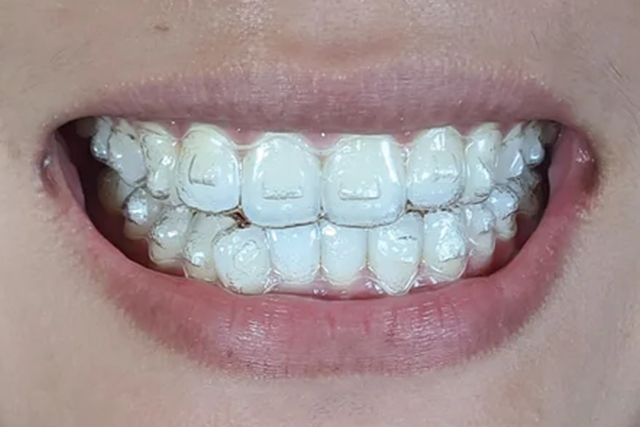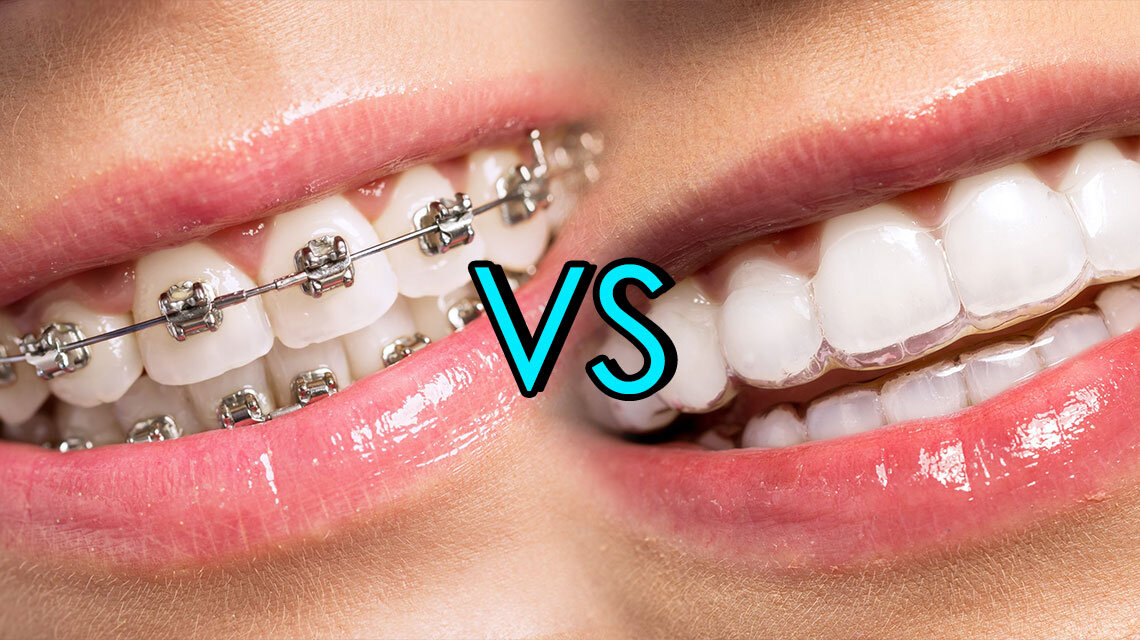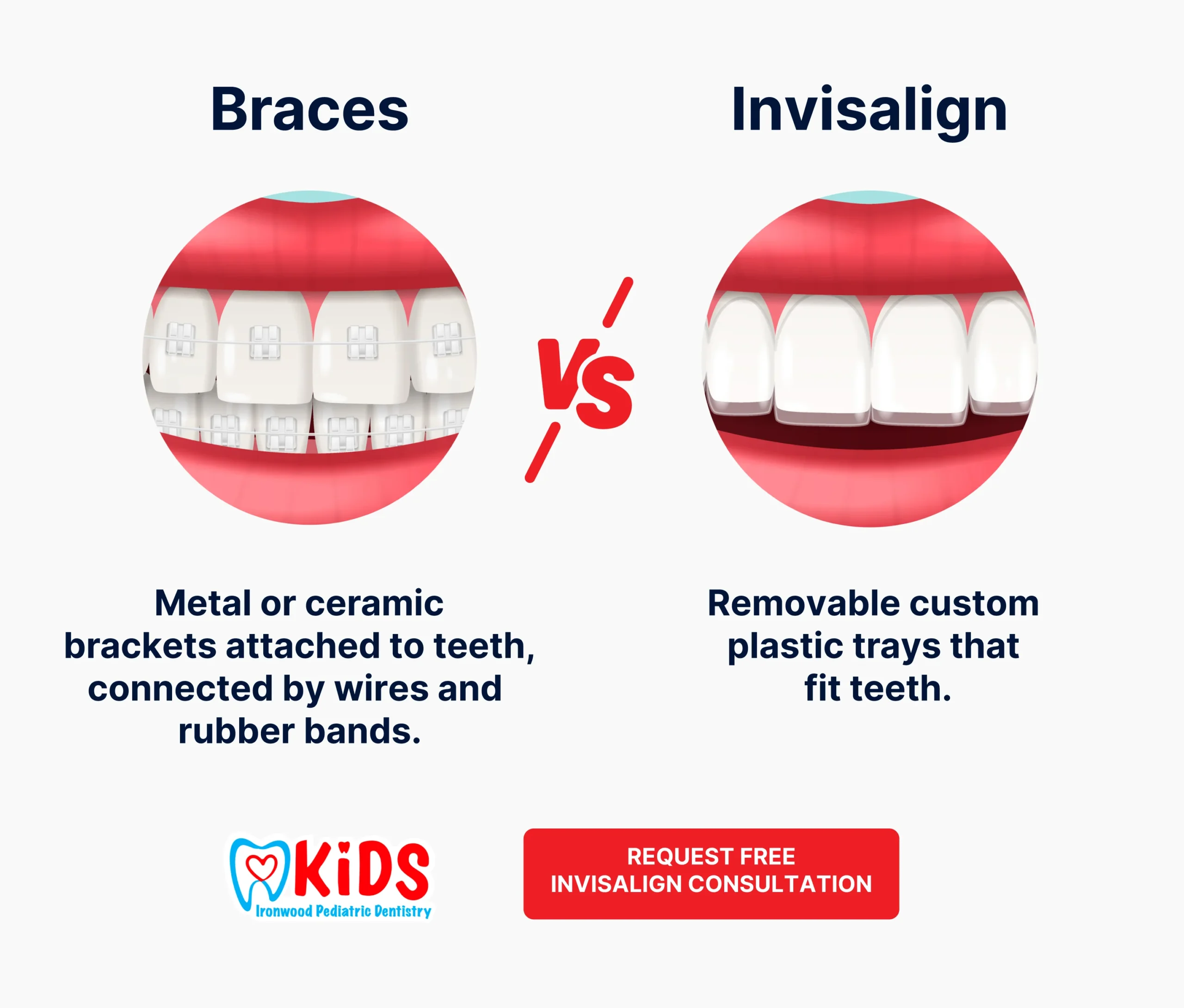Invisalign vs. Conventional Dental braces: Which Alternative Is Right for You?
When considering orthodontic treatment, the option in between Invisalign and typical braces presents a number of crucial variables that merit careful assessment. Invisalign uses a very discreet choice with detachable aligners, while typical braces supply an extra visible yet efficient remedy for extreme imbalance. Each alternative encompasses unique benefits and disadvantages associated with appearances, comfort, treatment period, and expense. Recognizing these subtleties is crucial for making an informed decision that aligns with your personal preferences and lifestyle. The inquiry stays: which choice will finest fulfill your orthodontic needs and assumptions?
Introduction of Treatment Alternatives

In comparison, traditional braces include steel brackets and cables that are adhered to the teeth. This method applies constant stress over time to accomplish placement. While effective for complex orthodontic issues, typical dental braces need normal check outs for adjustments and can posture difficulties in keeping oral hygiene due to the problem of cleansing about wires and brackets.
Both choices have their qualities, and the choice frequently rests on certain oral problems, way of living choices, and person conformity. Inevitably, speaking with an orthodontic professional is important for figuring out one of the most ideal therapy strategy customized to private requirements. Comprehending the nuances of each choice can substantially influence the general success of orthodontic therapy.
Aesthetic Considerations
A substantial aspect influencing the selection between Invisalign and traditional dental braces is the aesthetic allure each treatment offers. Invisalign aligners are crafted from clear plastic, making them basically undetectable when worn.
On the other hand, conventional dental braces consist of steel brackets and cords, which can be a lot more noticeable. While innovations in orthodontic innovation have actually resulted in the growth of smaller braces and colored elastics, standard braces still preserve an even more conspicuous account. For some people, the presence of dental braces may deter them from looking for necessary therapy.
Inevitably, the option between Invisalign and traditional dental braces may depend upon personal preferences pertaining to looks. Patients who focus on discernment frequently favor Invisalign, while those that are less concerned regarding presence may choose for standard dental braces. Understanding the aesthetic effects of each alternative is essential for making a notified choice that straightens with one's lifestyle and choices.
Convenience and Convenience

In regards to comfort, Invisalign aligners are removable, recommended you read enabling people to appreciate their preferred foods without restriction and keep optimum oral hygiene. Cleaning and flossing are simplified, as the aligners can be taken out throughout these routines, whereas traditional dental braces need careful steering around braces and wires.
In contrast, standard braces require normal adjustments, making them much less convenient for those with hectic timetables. In general, the convenience and ease of Invisalign make it an attractive selection for many individuals looking for orthodontic therapy.
Treatment Period and Performance
While both Invisalign and conventional dental braces are reliable in correcting dental imbalances, the period of therapy can vary substantially in between the two choices. Commonly, Invisalign treatment can take anywhere from 12 to 18 months, depending on the complexity of the situation. The clear aligners function by progressively shifting teeth into their desired settings, and routine follow-ups with an orthodontist assistance make certain progression remains on track.
On the other hand, standard dental braces usually call More Info for a longer dedication, usually ranging from 18 months to three years. This is due to their fixed nature and making use of wires and brackets, which can be much more efficient for serious misalignments and complicated situations (Invisalign). The treatment effectiveness of conventional braces is well-documented, as they enable precise adjustments and better control over tooth activity
Inevitably, the selection in between Invisalign and standard braces may depend upon both the awaited therapy period and the certain dental issues handy. Consulting with an orthodontist is critical, as they can give customized suggestions based on individual demands, ensuring the picked technique lines up with desired durations and outcomes.
Cost Comparison and Insurance Policy Alternatives
Expense plays a considerable function in the decision-making process for people thinking about orthodontic treatment, whether going with Invisalign or conventional dental braces. On standard, the cost of Invisalign arrays from $3,000 to $8,000, while standard braces commonly cost in between $2,000 and $6,000. Aspects influencing these prices include the intricacy of the situation, the period of therapy, and geographical location.
Insurance policy protection can significantly affect out-of-pocket expenses. Lots of dental insurance coverage plans supply partial coverage for orthodontic treatments, yet the specifics can vary extensively. It is essential for people to evaluate their insurance coverage to figure out the level of protection for either alternative. Generally, standard dental braces may be a lot more frequently covered by insurance coverage strategies contrasted to Invisalign, which some insurance companies classify as a cosmetic procedure.
In addition, numerous orthodontic practices provide versatile layaway plan, making both therapy options more available. Individuals must ask about possible funding alternatives and price cuts for upfront payments. Evaluating the total cost, including insurance benefits and payment plans, is essential for making an informed decision that aligns with both aesthetic choices and spending plan factors to consider.

Conclusion
In recap, the selection resource in between Invisalign and traditional braces hinges on multiple factors, including aesthetic preferences, convenience, treatment period, and price. Invisalign offers a discreet, removable option that assists in oral hygiene and nutritional adaptability, while typical dental braces may be preferable for intricate oral problems and commonly come with a lower rate factor. Eventually, assessment with an orthodontist is important to assess specific scenarios and identify the most ideal treatment alternative for achieving optimum dental alignment.
When taking into consideration orthodontic treatment, the choice in between Invisalign and conventional dental braces provides several crucial elements that warrant cautious evaluation.Contrasting Invisalign and conventional dental braces exposes distinctive treatment alternatives for orthodontic modification.While both Invisalign and traditional dental braces are effective in dealing with dental imbalances, the duration of treatment can differ substantially between the 2 options.Expense plays a significant function in the decision-making process for individuals considering orthodontic treatment, whether deciding for Invisalign or standard dental braces.In recap, the selection between Invisalign and typical braces pivots on numerous elements, consisting of aesthetic preferences, convenience, treatment period, and price.